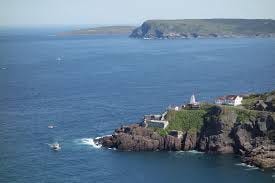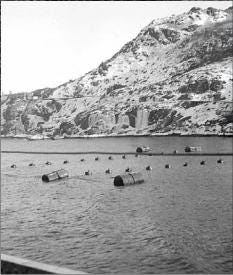Travel back in time to March 3rd, 1941, a night filled with tension and intrigue amidst the backdrop of World War II. Picture the rugged coastline of Newfoundland, where the German U-boat U-587, led by Captain Ulrich Borcherdt, embarked on a daring mission.
Under the cover of darkness, U-587 skillfully navigated past the defenses of Cape Spear and Signal Hill. With nerves of steel, the crew unleashed three torpedoes towards an unsuspecting steamer entering the St. John’s Harbor.
Two torpedoes struck the cliffs below Fort Amherst with a deafening roar, sending plumes of water into the air. But fate had other plans for the third torpedo, which became entangled in the harbor's anti-submarine nets, narrowly missing its target.
The audacity of this attack sent shockwaves through the Allied forces, prompting swift action to strengthen the harbour's defenses. By June 1942, new anti-torpedo nets crisscrossed the harbor, while a controlled minefield guarded its entrance.
This pivotal moment in history underscored the resilience of St. John's Harbor and the ingenuity of those who defended it.
St. John's WWII Coastal Defences National Historic Site of Canada is a defence complex strategically located at the approaches and entrance of St. John's inner harbour on the east coast of Newfoundland. The site comprises the ruins of three coastal fort batteries: Fort Cape Spear, Fort Chain Rock and Fort Amherst.
Description of Historic Place
St. John’s WWII Coastal Defences National Historic Site of Canada is a defence complex strategically located at the approaches and entrance of St. John’s inner harbour on the east coast of Newfoundland. The site comprises the ruins of three coastal fort batteries: Fort Cape Spear, Fort Chain Rock and Fort Amherst. All three batteries stand on rocky promontories overlooking the Atlantic Ocean. During the Second World War these coastal artillery batteries presented a formidable defensive line of fire which along with machine guns and protected the harbour and allied convoy ships. Resources from this period remain on all three locations and include concrete gun emplacements, magazines, searchlight emplacements, trenches and building foundations. Official recognition refers to the three batteries and their effective viewscapes.
Source
The robust rings of the Torpedo nets soared to heights of up to six feet, spanning wide expanses of the harbour entrance. Their mission was evident—to intercept lethal torpedoes and shield the city from ruin. Remarkably, they achieved this goal. Historical accounts tell of a moment when a torpedo, poised for destruction, was trapped within the barrier, thwarting its malevolent purpose. This occurrence stands as a powerful symbol of the barrier's efficacy and the valor of those who protected St. John's.
According to “The First Landfall: Historic Lighthouses of Newfoundland and Labrador,” a U-Boat’s torpedo was “caught without exploding in the submarine net strung across The Narrows at Chain Rock” on March 3, 1942.
The 1994 book — written by David Molloy — says that torpedo was the second one fired. The first exploded on the red cliff right below the Fort Amherst lighthouse.
Captain Joe Prim, a merchant navy veteran from WWII, had a wealth of stories to share about his experiences navigating the dangerous waters protected by the U-boat barrier. His tales painted a lively picture of life on the high seas during wartime, giving us a peek into the clever maneuvers that kept St. John's safe from harm.
He says there was actually a network of submarine nets in place, with neither spanning the entire distance from Chain Rock to Fort Amherst.
Efforts were in progress to conserve this tangible connection to St. John's wartime past. Advocates such as St. John's Councillor Frank Galgay stressed the significance of preserving a section of the barrier, not solely as a historical artifact, but as a concrete reminder of the sacrifices made to safeguard the city during WWII.
It’s one of the oddities The Telegram has come across in the area as it endeavours to find out more about the military waste dumped there.
What looks like an anti-submarine net used to stifle offences by Nazi subs sits rusting in the White Hills, between a developed trail and the foundation of the radio tower the U.S. Army once operated.
Keep reading with a 7-day free trial
Subscribe to The Newfoundland History Sleuth to keep reading this post and get 7 days of free access to the full post archives.






